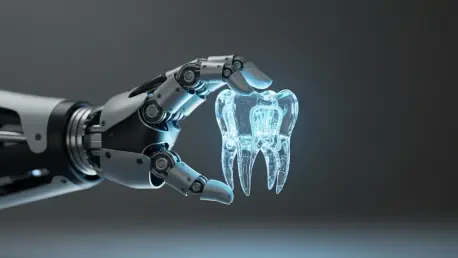The Current State of the Dental Industry and AI’s Emerging Role
The dental industry stands as a critical pillar of healthcare, serving millions of patients annually while generating substantial revenue, with global market estimates surpassing hundreds of billions of dollars. Dental practices, ranging from small family offices to large multi-location chains, face a complex operational landscape marked by high patient volumes, intricate scheduling demands, and stringent regulatory requirements. This sector, while vital, often struggles with inefficiencies that hinder growth and patient satisfaction, creating a pressing need for innovative solutions to streamline daily operations.
Among the most significant challenges are missed patient calls, with studies suggesting that 30-35% of inquiries go unanswered, leading to an estimated annual revenue loss of $75 billion across the industry. Administrative burdens further compound the issue, as staff juggle repetitive tasks like appointment booking and patient follow-ups, often at the expense of direct care. These inefficiencies, coupled with chronic understaffing, drain resources and limit the ability of practices to scale effectively or focus on patient-centric services.
Technology, particularly artificial intelligence (AI), has begun to emerge as a transformative force to address these pain points. AI promises to automate routine tasks, enhance communication, and recover lost revenue by ensuring no patient interaction slips through the cracks. Startups like Annie are at the forefront of this shift, alongside a growing field of competitors vying to redefine dental operations. As the market becomes increasingly crowded, the race to deliver practical, impactful solutions shapes a dynamic and competitive environment, pushing the boundaries of how technology integrates into traditional healthcare settings.
Annie’s $4M Funding and Its Significance
Details of the Seed Round and Investor Confidence
Annie, a Lehi, Utah-based startup, recently secured a $4 million seed funding round, co-led by Las Olas Venture Capital and Chicago Ventures, with additional backing from Gamba Ventures. This substantial investment reflects strong belief in Annie’s mission to revolutionize dental practices through a practical AI platform designed to tackle operational inefficiencies head-on. The involvement of prominent venture capital firms signals a vote of confidence in the startup’s ability to address real-world challenges like missed calls and administrative overload.
The funding arrives at a pivotal moment, positioning Annie to stake a claim in what industry insiders describe as a “land grab” within the dental AI market. With Nate Vasel of Las Olas joining the Board of Directors, the strategic guidance from investors underscores their commitment to helping Annie carve out a significant share of this rapidly evolving sector. This financial boost is not just about capital but about aligning with partners who see the potential for AI to fundamentally improve how dental offices operate.
Market Potential and Growth Outlook
Early metrics from Annie’s deployment across hundreds of practices highlight its tangible impact, with the platform already generating $5 million in customer revenue and saving over 30,000 staff hours—equivalent to 3.5 years of labor. These figures demonstrate the immediate value of automation in reducing workload and plugging revenue leaks, offering a glimpse into the broader potential for AI in dentistry. As adoption rates climb, the dental AI market is poised for significant expansion, with increasing demand for tools that streamline operations.
Looking ahead, projections suggest robust growth for Annie and similar solutions through 2026 and beyond, driven by the industry’s urgent need for efficiency. The $4 million infusion will fuel enhancements to Annie’s platform, including deeper integrations with practice management systems and expanded features to address evolving needs. This strategic investment positions the company to scale rapidly, targeting broader market penetration and solidifying its foothold in a competitive landscape hungry for innovation.
Challenges in Implementing AI in Dental Practices
Adopting AI in dental practices is not without hurdles, particularly when it comes to integrating new technologies with existing practice management systems. Many offices rely on legacy software that may not easily accommodate modern AI tools, leading to compatibility issues and potential disruptions during implementation. This technical friction can slow down deployment and frustrate staff accustomed to familiar workflows, posing a barrier to widespread acceptance.
Beyond integration, concerns about cost and training loom large for dental practices considering AI solutions. The upfront investment, coupled with the need to upskill staff to interact with automated systems, can deter smaller offices with limited budgets. Additionally, there is a risk of over-reliance on technology, where automation might erode the personal touch that defines patient relationships, prompting skepticism among practitioners wary of sacrificing human interaction for efficiency.
The dental AI space also faces intense competitive pressure, with numerous startups entering the fray, some offering solutions that prioritize hype over substance. Market saturation with underperforming or overpromised tools could undermine trust in the technology as a whole, making differentiation critical. To navigate these challenges, companies like Annie must emphasize practical utility, ensure seamless onboarding, and maintain a balance between automation and human oversight to build lasting confidence among dental professionals.
Regulatory and Compliance Considerations for Dental AI
Navigating the regulatory landscape is a crucial aspect of deploying AI in healthcare, particularly in dentistry where patient data sensitivity is paramount. Strict data privacy laws and security standards govern how information is handled, requiring AI platforms to adhere to rigorous protocols to protect confidential records. Failure to meet these requirements can result in significant legal and reputational consequences for both technology providers and dental practices.
Compliance with regulations such as HIPAA in the United States is non-negotiable, mandating that AI systems safeguard patient information while ensuring secure data transmission across communication channels. Platforms like Annie must prioritize transparency, giving practices full control over which tasks are automated and how data is managed. This approach not only mitigates risk but also fosters trust, a critical component in an industry where patient privacy remains a top concern.
As regulations continue to evolve, staying ahead of policy changes will be essential for AI providers in dentistry. Emerging guidelines may impose new requirements on data usage, algorithmic transparency, and accountability, potentially influencing how quickly and widely these tools are adopted. Companies that proactively address compliance and build robust safeguards into their systems will likely gain a competitive edge, reinforcing industry confidence in AI as a reliable partner in dental care.
The Future of AI in Dental Care: Opportunities and Disruptors
AI tools hold immense potential to reshape dental operations by introducing advanced capabilities that go beyond basic automation. Solutions like Annie could evolve to offer predictive analytics for patient behavior, personalized engagement strategies, and seamless integrations with a wider array of systems, enhancing their value proposition. Such advancements would enable practices to anticipate needs, optimize scheduling, and deliver tailored care, fundamentally improving operational outcomes.
Emerging trends point to proactive patient engagement and round-the-clock communication as key drivers of growth in this space. The ability to interact with patients at any time through multiple channels—phone, web, or messaging—addresses a critical gap in current systems, ensuring no opportunity is missed. These innovations, fueled by ongoing technological progress, suggest a future where AI becomes an indispensable component of dental practice management, provided adoption barriers are overcome.
However, disruptors lurk on the horizon, including new market entrants with novel approaches, rapid advancements in competing technologies, and shifting consumer expectations for digital-first experiences. Economic fluctuations and regional tech ecosystem dynamics, such as Utah’s growing prominence as a startup hub, could also influence the sector’s trajectory. Staying agile amid these variables will be crucial for companies aiming to lead the dental AI revolution, as adaptability will determine who thrives in an increasingly complex landscape.
Final Thoughts
Reflecting on Annie’s journey, the $4 million seed funding marked a defining chapter that propelled the startup into a position of strength within the dental AI arena. The investment, paired with early successes in generating substantial revenue and saving countless staff hours, underscored the transformative power of practical automation in addressing deep-rooted industry challenges. Annie’s commitment to real-world utility over empty promises set a benchmark for others in a crowded market.
Moving forward, dental practices exploring AI adoption should prioritize solutions that integrate seamlessly, offer clear cost-benefit outcomes, and preserve the human element in patient care. For investors, this niche presents untapped potential, but careful evaluation of scalability and differentiation is advised. As the sector evolves, fostering collaboration between technology providers and practitioners will be key to unlocking AI’s full promise, ensuring that innovation serves as a true ally in enhancing dental care delivery.









